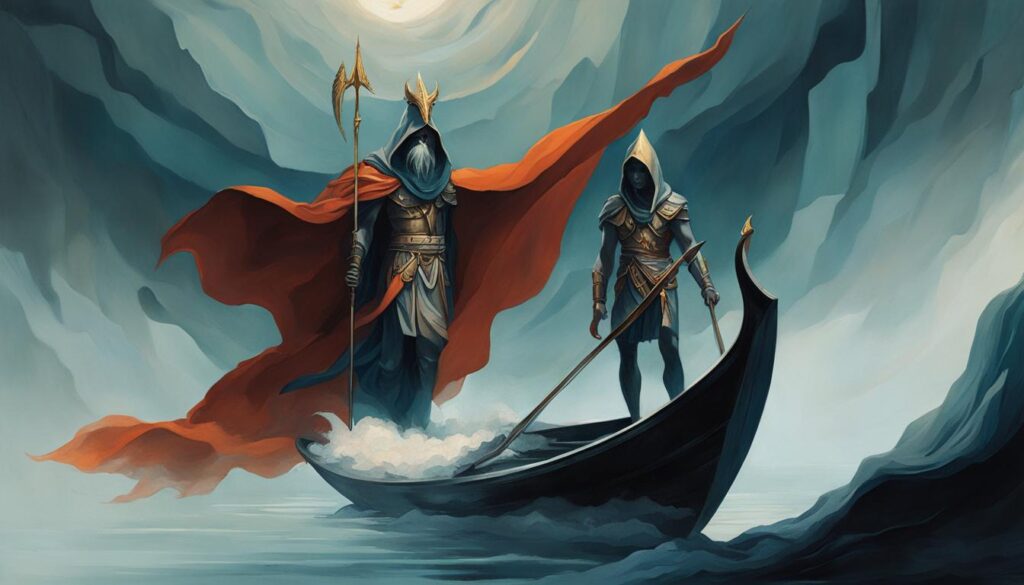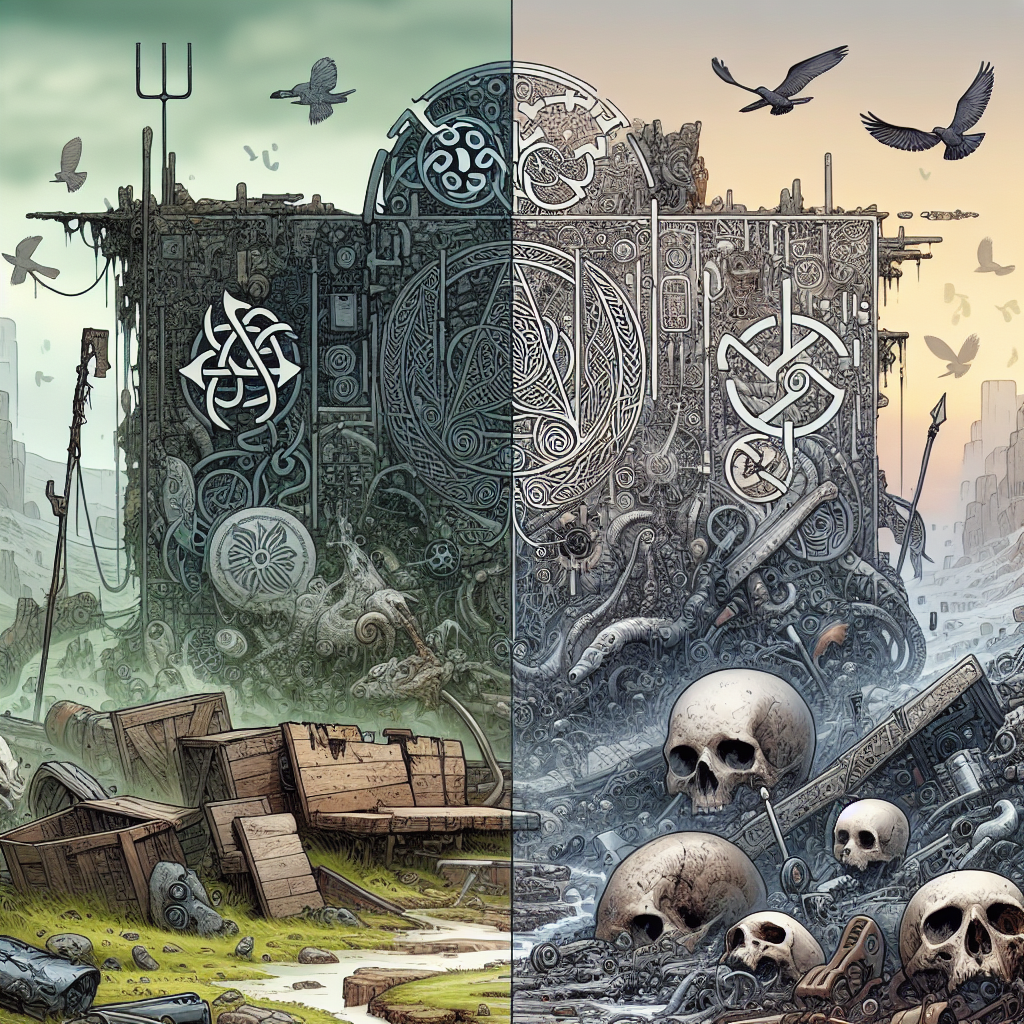Charon and Hermes are both mythological figures associated with guiding the souls of the dead to the afterlife, but they have distinct roles and characteristics. Charon is the ferryman of the Greek underworld, carrying souls across the rivers Acheron and Styx. He is often depicted as a rough seaman in ancient Greek art. In contrast, Hermes is the messenger of the gods and is responsible for guiding souls to the entrance of Hades. He is depicted as a youthful and agile figure, often shown with his caduceus staff. While both play important roles in mythology, their responsibilities and appearances differ.
Key Takeaways:
- Charon and Hermes are both psychopomps in Greek mythology.
- Charon ferries souls across the rivers Acheron and Styx, while Hermes leads them to the entrance of Hades.
- Charon is depicted as a rough seaman, while Hermes is portrayed as a youthful figure with a caduceus staff.
- Their roles and symbolism convey the significance of the journey from the earthly realm to the realm of the dead.
- Charon and Hermes continue to captivate and inspire with their distinct characteristics and timeless significance.
Charon as a Psychopomp
Charon, also known as Kharon, is a prominent figure in Greek mythology as a psychopomp. He is responsible for ferrying the souls of the deceased across the rivers Acheron and Styx to the Greek underworld, also known as Hades. The souls would pay Charon a fee to cross, typically by placing coins in or near their mouth. This ritual was reflected in some Greek and Roman funeral practices. Charon’s appearance in artwork varied over time, with early depictions portraying him as a rough and unkempt seaman, while later portrayals showed him with a more refined demeanor.
Charon’s role as a psychopomp highlights the significance of the transition from life to death in Greek mythology. He serves as a guide and transport for the souls, ensuring their safe passage to the afterlife. The act of paying the ferryman symbolizes the importance of proper preparation for the journey and acknowledging the boundary between the mortal and spiritual realms. Charon’s appearance, whether rugged or refined, reflects the duality of his role as both a practical transport and a symbolic figure in the transition between life and death.
| Characteristics | Symbolism |
|---|---|
| Rough or refined appearance | Reflecting the transition from life to death |
| Fee for crossing | Emphasizing the importance of preparation and acknowledgement |
| Transporting souls | Guiding the deceased to the afterlife |
Summary
- Charon is a psychopomp in Greek mythology, responsible for ferrying the souls of the deceased across the rivers Acheron and Styx to the Greek underworld.
- In some Greek and Roman funeral practices, the deceased would place coins in or near their mouth as payment for Charon’s services.
- Charon’s appearance in artwork varied over time, ranging from a rough and unkempt seaman to a more refined demeanor.
- His role as a psychopomp symbolizes the significance of the transition from life to death, with his appearance and the fee for crossing emphasizing the preparation and acknowledgement required for the journey.
Hermes as a Psychopomp
Hermes, the messenger of the gods in Greek mythology, played an important role as a psychopomp. As a guide to the afterlife, Hermes was responsible for leading the souls of the deceased to the entrance of Hades, where they would continue their journey under the care of Charon. Unlike Charon, Hermes did not require a payment for his services and focused on guiding the souls to the point of transition between realms.
In mythology, Hermes is often depicted as a youthful and agile figure. His ability to traverse between the realms of the living and the dead is symbolized by his caduceus staff, which he is often shown carrying. This staff represents his role as a guide and marks him as a psychopomp. With his swift and agile nature, Hermes ensured that souls reached the entrance of Hades, where they could receive further guidance from Charon.
Throughout Greek mythology, Hermes is depicted as a multifaceted figure with various responsibilities. As the messenger of the gods, he possessed the ability to move effortlessly between different realms and communicate with both mortals and immortals. This made him an ideal guide for the souls making their way to the afterlife. Hermes’ role as a psychopomp highlights his significance as a mediator between the mortal world and the divine, ensuring a smooth transition for the souls of the deceased.
Symbols and Representations of Hermes
Symbolically, Hermes is associated with several key elements. His caduceus staff represents his role as a psychopomp and is often portrayed as a winged staff entwined by two serpents. This staff is believed to possess the power to guide and protect the souls on their journey. Additionally, Hermes is associated with a pair of winged sandals, known as talaria, which grant him the ability to travel swiftly between the realms.
| Symbol | Meaning |
|---|---|
| Caduceus Staff | Represents Hermes as a psychopomp and his ability to guide and protect souls |
| Talaria (winged sandals) | Symbolizes Hermes’ agility and swiftness in guiding souls between realms |
Hermes’ symbolism as a psychopomp and his role in guiding the souls of the deceased highlights the importance of his position in Greek mythology. His ability to navigate between realms and facilitate the transition between life and death solidify his significance as a messenger and guide.
Roles and Responsibilities of Charon and Hermes
In Greek mythology, both Charon and Hermes play crucial roles as guides to the afterlife. While their overall purpose is to assist the souls of the deceased on their journey to the underworld, their specific responsibilities differ.
Charon: As the ferryman of the Greek underworld, Charon’s primary role is to transport the souls of the deceased across the rivers Acheron and Styx. He ensures that those who have passed away receive their proper passage into the afterlife. In ancient Greek art, Charon is often depicted as a rough seaman, reflecting the somber nature of his duty.
Hermes: In contrast, Hermes serves as a guide to the entrance of Hades, where the souls are then received by Charon. As the messenger of the gods, Hermes is known for his agility and ability to traverse between the realms of the living and the dead. He leads the souls to the point of transition, ensuring they are prepared for their journey under the care of Charon.
While Charon is directly involved in the physical transportation of souls, Hermes plays a crucial role in guiding them to the underworld. Their collaboration illustrates the intricate process of transitioning from the mortal realm to the realm of the dead.
| Charon | Hermes | |
|---|---|---|
| Responsibilities | Transporting souls across rivers Acheron and Styx | Guiding souls to the entrance of Hades |
| Appearance | Rough seaman | Youthful and agile figure |
| Symbolism | Connection to the underworld and the somber nature of death | Ability to traverse between realms and guide the souls |
Characteristics and Symbolism of Charon and Hermes
Charon and Hermes, as prominent figures in Greek mythology, possess distinct characteristics and symbolism that contribute to their enduring significance.
Charon, the ferryman of the Greek underworld, is often depicted as a rough and unkempt seaman in ancient Greek art. This portrayal emphasizes his connection to the somber task of guiding souls to the afterlife. In contrast, Hermes, the messenger of the gods, is depicted as a youthful and agile figure, symbolizing his role as a guide between the realms of the living and the dead. He is often shown holding his caduceus staff, which represents his ability to traverse between worlds.
The symbolism of Charon and Hermes reflects their respective roles as psychopomps. Charon’s appearance as a rough seaman conveys the seriousness and finality of death, while Hermes’ youthful depiction signifies the transition and journey of the soul. Both figures embody the liminal space between life and death, guiding souls on their path to the afterlife.
| Characteristics | Charon | Hermes |
|---|---|---|
| Appearance | Rough and unkempt seaman | Youthful and agile, often shown with caduceus staff |
| Symbolism | Connection to the somber task of guiding souls to the afterlife | Representation of the transition and journey of the soul |
Mythological Origins and Legends of Charon and Hermes
Charon and Hermes are iconic figures in Greek mythology, renowned for their roles as psychopomps. Their origins and legends are deeply rooted in ancient Greek beliefs and religious practices. Charon’s first appearance can be traced back to the ancient Greek epic poem Minyas, which dates back to the 6th century BC. This poem describes a journey to the underworld, where Charon is depicted as the ferryman of the dead, guiding souls across the rivers Acheron and Styx to the Greek underworld, also known as Hades. Over time, Charon’s role as a psychopomp became an integral part of Greek funeral practices, with rituals often involving the placement of coins in or near the deceased’s mouth to pay for their passage into the afterlife.
Hermes, on the other hand, is a multifaceted figure in Greek mythology. He is not solely associated with guiding souls to the afterlife but also serves as the messenger of the gods. Hermes has appeared in numerous Greek myths and legends, with his origins intertwined with ancient Greek religious beliefs and rituals. As a psychopomp, Hermes guides the souls of the deceased to the entrance of Hades, where they are then received by Charon for further transportation into the underworld. Hermes’ agility and ability to traverse between realms make him a crucial figure in the journey of the soul after death.
| Charon | Hermes |
|---|---|
| First appearance in the ancient Greek epic poem Minyas | Appears in various Greek myths and legends |
| Ferryman of the dead, guiding souls across the rivers Acheron and Styx | Guides souls to the entrance of Hades |
| Evolved into an important aspect of Greek funeral practices | Associated with various roles, including messenger of the gods |
Charon and Hermes have left a lasting impact on Greek mythology and continue to captivate audiences with their rich legends and symbolism. Their roles as psychopomps highlight the significance of the journey from the mortal realm to the afterlife, providing a link between the living and the dead. As prominent figures in Greek mythology, Charon and Hermes serve as reminders of the complex beliefs and rituals associated with death and the beyond.

Cultural and Artistic Depictions of Charon and Hermes
The mythological figures of Charon and Hermes have captivated the imagination of artists throughout history. Their distinct roles and symbolism in Greek mythology have been depicted in various forms of art and literature, showcasing the cultural significance attributed to these psychopomps.
Ancient Greek funerary vases often depicted scenes of Charon ferrying the souls of the deceased, emphasizing his role as a guide to the afterlife. These early portrayals presented Charon as a rough and unkempt seaman, emphasizing the somber nature of his task. Hermes, on the other hand, has been a recurring figure in countless works of art. He is often depicted as a youthful and agile messenger of the gods, holding his caduceus staff as a symbol of his role in guiding souls between realms.
Both Charon and Hermes continue to inspire artists to this day, as their depictions in art serve as a visual representation of the mythological narratives. These artistic interpretations provide a glimpse into the ancient Greek belief system and the importance placed on the journey of the soul after death. The artistic depictions of Charon and Hermes serve as a testament to their enduring cultural significance and their ability to transcend time and inspire generations.
| Artistic Depictions of Charon | Artistic Depictions of Hermes |
|---|---|
| Ancient Greek funerary vases | Statues and sculptures |
| Paintings and murals | Reliefs and engravings |
| Illustrations in ancient Greek texts | Contemporary artwork and digital art |
Table: Examples of Artistic Depictions of Charon and Hermes
The table above showcases some examples of the artistic depictions of Charon and Hermes. It highlights the various mediums in which these mythological figures have been represented, ranging from ancient Greek funerary vases to contemporary digital art. These artistic interpretations provide insights into the visual symbolism associated with Charon and Hermes, as well as their enduring presence in art across different time periods.
By showcasing the contrasting appearances and roles of Charon and Hermes in art, these depictions contribute to a deeper understanding of their symbolism and cultural significance in Greek mythology.
Other Psychopomps in Mythology
In addition to Charon and Hermes, there are several other psychopomps in various mythologies around the world. These figures play crucial roles in guiding the souls of the deceased to the afterlife, each with their own unique characteristics and significance.
Azrael
Azrael is an angelic figure in Islamic mythology who is often depicted as the Angel of Death. In this role, Azrael helps guide the souls of the deceased to Allah upon their passing. His presence brings comfort and reassurance to those who are transitioning from the earthly realm to the spiritual realm.
Charun
In Etruscan mythology, Charun is a demon of death who serves as a psychopomp. He not only escorts the souls of the deceased to the underworld but also administers punishment to those who have committed wrongdoings in their lifetime. Charun’s menacing appearance and stern demeanor reflect his role as a guardian and enforcer of the afterlife.
Valkyries
In Norse mythology, the Valkyries are female warrior spirits who choose which fallen warriors are worthy of entering Valhalla, the majestic hall of the gods. These fierce and powerful beings guide the souls of slain heroes to their final resting place in the realm of the gods, where they will participate in eternal battles and revelry.
Mercury
Mercury, known as Hermes in Greek mythology, is also considered a psychopomp in Roman mythology. Just like his Greek counterpart, Mercury guides the souls of the deceased to the underworld. As the messenger of the gods, he uses his quick wit and agility to navigate between the realms of the living and the dead, ensuring the safe passage of souls.
Anubis
In ancient Egyptian mythology, Anubis is the god associated with death and the afterlife. He plays a significant role as a psychopomp, leading souls to the judgment of the afterlife. Anubis is often depicted with the head of a jackal, symbolizing his connection to death and his role as a guardian of the deceased.
Thanatos
Thanatos, the personification of death in Greek mythology, is responsible for the transition of souls from the mortal world to the afterlife. Often depicted as a gentle figure, Thanatos ensures a peaceful passing for the souls under his care. He represents the natural cycle of life and death, guiding souls on their journey to the other side.
Grim Reaper
The Grim Reaper is a widely recognized figure in various cultural beliefs and folklore. Often depicted as a skeletal figure holding a scythe, the Grim Reaper serves as a psychopomp who guides souls to the afterlife. This iconic representation of death signifies the universality of mortality and the inevitable transition from life to death.
| Pychopomp | Mythology |
|---|---|
| Azrael | Islamic |
| Charun | Etruscan |
| Valkyries | Norse |
| Mercury | Roman |
| Anubis | Egyptian |
| Thanatos | Greek |
| Grim Reaper | Various Cultures |
Table: Other Psychopomps in Mythology
Symbolism and Significance of Psychopomps
Psychopomps, such as Charon and Hermes, hold deep symbolism and significance in various cultures and mythologies. As guides of the soul, they represent the transition between life and death, helping souls navigate their journey from the mortal realm to the afterlife. In mythology, psychopomps serve as intermediaries, connecting the earthly realm with the divine realm.
The symbolism associated with psychopomps varies across different belief systems. In Greek mythology, Charon is often depicted as the ferryman of the dead, symbolizing the journey across the rivers Acheron and Styx. His appearance as a rough seaman reflects his role as a guide to the underworld. Hermes, on the other hand, embodies agility and youthfulness as the messenger of the gods. With his caduceus staff, he symbolizes his ability to traverse between realms and guide souls to the entrance of Hades.
In broader cultural contexts, psychopomps represent the universal human fascination with the afterlife and the unknown. They embody the idea of transition and transformation, offering comfort and guidance during times of uncertainty and loss. Psychopomps also remind us of the profound connection between the mortal world and the realm of the divine, serving as reminders of the spiritual and transcendent aspects of human existence.
Table: Symbolism and Significance of Psychopomps
| Psychopomp | Symbolism | Significance |
|---|---|---|
| Charon | Guiding souls across rivers Acheron and Styx, rough seaman | Transition from life to afterlife, connection between mortal realm and the underworld |
| Hermes | Caduceus staff, agility, messenger of the gods | Transition to the entrance of Hades, guidance between realms, connection between mortal realm and the divine |
| Other Psychopomps | Varies across different mythologies and cultures | Representations of transition, guides to the afterlife |
Psychopomps hold a significant place in human consciousness, reflecting our deep-seated questions about mortality and what lies beyond. Their symbolism and significance continue to captivate and inspire, inviting contemplation and reflection on the mysteries of life and death.
Conclusion
Charon and Hermes are both psychopomps in Greek mythology, responsible for guiding the souls of the dead to the afterlife. Charon’s role is to ferry the souls across the rivers Acheron and Styx, while Hermes leads them to the entrance of Hades. The significance of their roles goes beyond the physical transportation of souls; they symbolize the journey from the earthly realm to the realm of the dead.
Charon, depicted as a rough seaman, represents the somber nature of death and the underworld. His task is to ensure that the deceased receive their proper passage into the afterlife. On the other hand, Hermes, portrayed as a youthful and agile figure, symbolizes the communication between the mortal world and the divine. He guides the souls to the point of transition, leading them to Charon for their onward journey.
As prominent figures in mythology, Charon and Hermes continue to captivate and inspire with their distinct characteristics and timeless significance. Their roles as psychopomps reflect the universal human fascination with the mysteries of death and the afterlife. Through art, literature, and ancient rituals, they serve as reminders of the delicate balance between life and death, and the eternal journey that awaits us all.
FAQ
What is the difference between Charon and Hermes as psychopomps?
Charon is the ferryman of the Greek underworld, responsible for carrying souls across the rivers Acheron and Styx. Hermes, on the other hand, is the messenger of the gods and guides souls to the entrance of Hades.
What is Charon’s role as a psychopomp?
Charon’s primary task is to ferry the souls of the deceased across the rivers Acheron and Styx to the Greek underworld.
What is Hermes’ role as a psychopomp?
Hermes guides the souls of the deceased to the entrance of Hades, where they are then received by Charon.
How do Charon and Hermes differ in appearance?
Charon is often depicted as a rough and unkempt seaman, while Hermes is depicted as a youthful and agile figure, often shown with his caduceus staff.
Are there other psychopomps in mythology?
Yes, other cultures and mythologies have their own versions of psychopomps, such as Azrael, Charun, Valkyries, Mercury, Anubis, Thanatos, and the Grim Reaper.
What is the symbolism and cultural significance of psychopomps?
Psychopomps symbolize the transition between life and death, guiding souls from the earthly realm to the afterlife. They hold important religious and spiritual beliefs and serve as guides and facilitators in the journey of the soul after death.
 Skip to main content
Skip to main content


